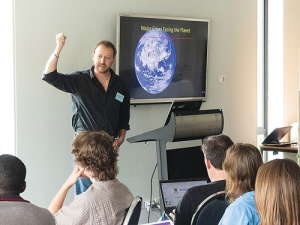NZ kiwifruit sector on alert for mysterious Italian disease
New Zealand's kiwifruit industry is on alert following reports of a mystery disease that is sweeping through Italian orchards.
 American entomologist Dr Jon Lundgren speaks at a workshop on biological pest control, organised by the Bio-Protection Research Centre, Lincoln University.
American entomologist Dr Jon Lundgren speaks at a workshop on biological pest control, organised by the Bio-Protection Research Centre, Lincoln University.
Agrichemicals are an addiction and pests are not the problem, claims a visiting American entomologist, Dr Jon Lundgren.
Lundgren promotes “regenerative agriculture” – a term he says is now replacing “sustainable” agriculture.
The FAO estimates that the world has only 60 years of topsoil left, he said.
“So we can’t just be sustaining a degraded resource. We need to be regenerating that, while producing our food.”
That requires re-growing soil and biodiversity on farms.
“I think farmers are realising more and more that their profits are decreasing. It’s getting harder and harder to farm the way we’ve been.
“We are just degrading that natural resource base and the writing is on the wall about how long we can do that.”
Lundgren was speaking at a four-day workshop on biological pest control run by the Lincoln University Bio-Protection Research Centre.
He told the workshop that pests are a symptom of underlying imbalance, and monoculture agriculture is the central problem.
“The way we approach food production is way, way too simplified.”
Lundgren runs a research centre on a small farm in South Dakota, surrounded by large monoculture cropping farms and continuously grazed beef farms.
“This is kind-of ‘ground zero’ for where change really needs to happen.”
Biodiversity was how habitats used to function and when you eliminate the diversity from a system the only thing left is to dose with agrichemicals, yet the ranchers with the most pests are the ones using the most pesticide use, he said.
One researcher showed that avermectins, commonly used in drenches, passed through the animal and then killed 98% of the insects living in dung, when only 1.7% of those were actually pests.
The first step to regenerative agriculture is to abandon the pesticides, said Lundgren.
“Usually within the first year you see that these natural balances of communities start to re-establish.”
Regenerative ranchers who replace pesticide use with good management find it a good business decision, he said.
The second step, for graziers, is to mimic natural grazing patterns by high-intensity grazing in small areas, frequently moving the stock and leaving the heavily grazed pasture to regrow for as much as a year before it is grazed again.
“We can learn a lot from the way they used to produce food, back before industrialisation.
“Technology has shown us what some of the yield potentials and profit potentials are, but I think we’ve reached a plateau in how far we can push things.”
Legal controls on the movement of fruits and vegetables are now in place in Auckland’s Mt Roskill suburb, says Biosecurity New Zealand Commissioner North Mike Inglis.
Arable growers worried that some weeds in their crops may have developed herbicide resistance can now get the suspected plants tested for free.
Fruit growers and exporters are worried following the discovery of a male Queensland fruit fly in Auckland this week.
Dairy prices have jumped in the overnight Global Dairy Trade (GDT) auction, breaking a five-month negative streak.
Alliance Group chief executive Willie Wiese is leaving the company after three years in the role.
A booklet produced in 2025 by the Rotoiti 15 trust, Department of Conservation and Scion – now part of the Bioeconomy Science Institute – aims to help people identify insect pests and diseases.